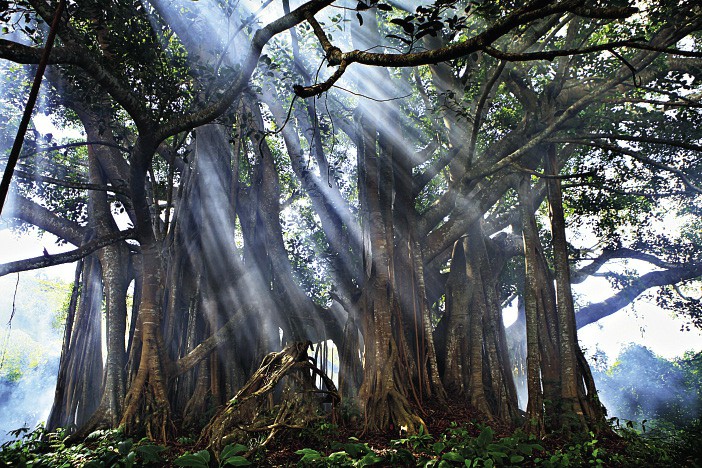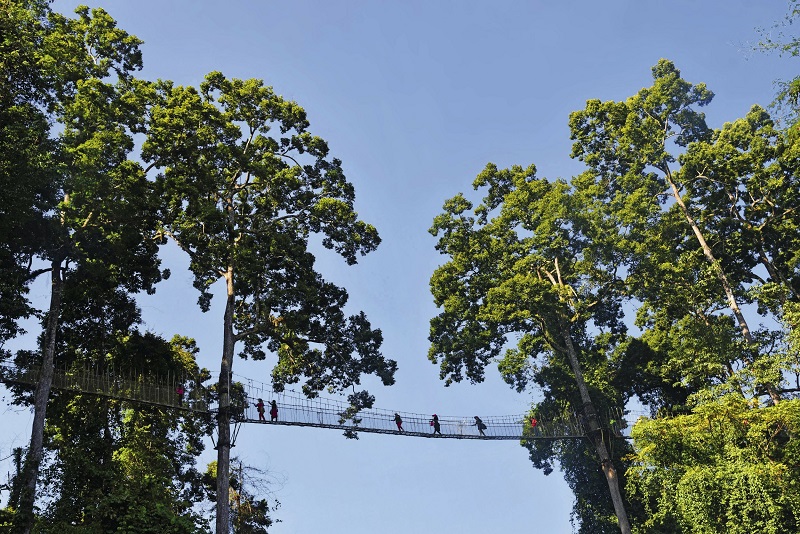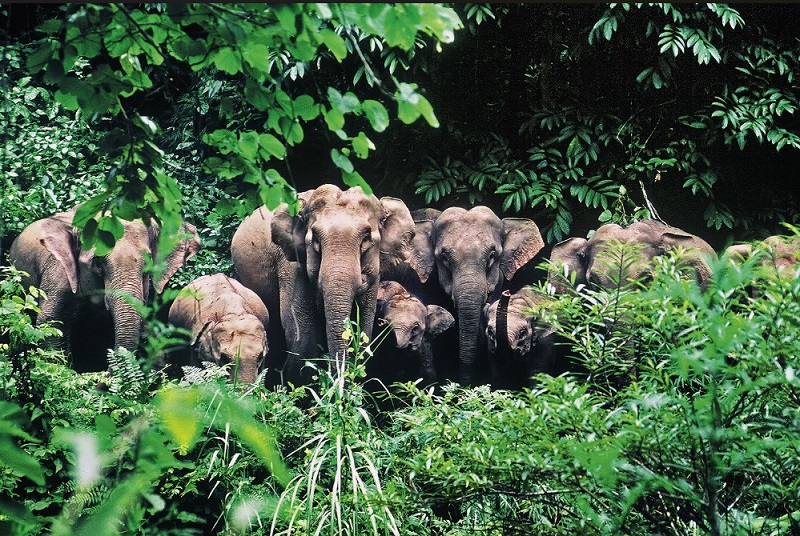A green world boasts numerous tropical wonders and fosters a harmonious bond between nature and human.
On the night of May 27, 2021, 15 elephants swaggered their way down an empty street in Eshan County of Yuxi City in Yunnan Province. These elephants are rarely-seen wild Asian elephants. They left home in March to embark on a food-hunt journey that took them towards the north. Seven months later, they returned to their home — the Wild Elephant Valley of the Xishuangbanna National Nature Reserve.

A few tall trees in a forest in the Wild Elephant Valley of Xishuangbanna are distinguished for their height.
A Member of the Biosphere Reserve Network
Established in 1958, Xishuangbanna National Nature Reserve is one of China’s first nature reserves. As a large nature reserve serving multiple purposes, it focuses on protecting tropical forest ecosystems and rare wildlife, features a relatively well-preserved tropical forest ecosystem and extremely rich biological resources, and is also the largest tropical primeval forest in China.
The reserve is located in Xishuangbanna Dai Autonomous Prefecture in Yunnan. Unlike most other reserves that are made up of one complete single enclosed area, the Xishuangbanna National Nature Reserve is composed of five geographically disconnected sub-reserves: Mengyang Reserve, Menglun Reserve, Mengla Reserve, Shangyong Reserve, and Mangao Reserve. They are located in two counties and one city, covering a total area of 242, 500 hectares.
In 1993, the nature reserve became a member of UNESCO Biosphere Reserve Network (also known as Xishuangbanna World Biosphere Reserve).
Survival Law of the Jungle
The rainforest in the reserve boasts an abundance of vegetation as well as various peculiar sights.
Many of these fascinating sights are actually filled with murders and even ferocious battles. “Strangler” is a common phenomenon in tropical rainforests. Banyan is a typical strangler: its fruits are eaten by birds, the birds then excrete the undigestible seeds onto the branches. These seeds germinate in suitable conditions and the young seedlings produce aerial prop roots that grow downwards along the trunk of the host trees. The roots gradually thicken, grow up, and form nets that gradually wrap and strangle the host trees, robbing them of nutrients and sunlight. Eventually, extreme nutrient deficiency results in the deaths of nearly all the host trees and plants.
To compete for sunlight, some tropical rainforest plants also exhibit a marvoulous property called cauliflory, which means they can flower and fruit on stems. In zones whre temperatures are temperate or frigid, almost all the woody plants flower on the first or second-year shoots. However, in tropical rainforests, some plants flower and produce fruits on old branches and trunks, or even the base of the trunk, such as jackfruit and Mayodendron igneum. Cauliflory is an adaptive result of the layered structure of the tropical rainforest. It is difficult for the plants at the lower levels in the forest to receive sunlight due to the layers of thick branches and leaves above them. As a result, plants at the lower layer develop cauliflory to facilitate pollination and seed dispersal through insects, because the room is more spacious around old branches and stems, and therefore those flowers are more likely to be found and visited by insects.

Visitors walking on the Canopy Air Corridor in Xishuangbanna on December 10, 2016.
Sky Tree Scenic Park
At the Sky Tree Scenic Park in the county of Mengla, tourists who are not afraid of heights can walk on the canopy air corridor, which is 500 meters long, 36 meters high above the ground, and is known as the highest canopy corridor in Asia.
The canopy corridor is smoothly connected by a long line of tall trees. Among the thousands of species of large trees in Xishuangbanna rainforest is the Parashorea chinensis (literraly meaning “sky tree”), which is generally 50-60 meters tall, but can grow to a height of over 80 meters. A fun fact is that, because this type of tree is so tall, its seeds have wings like the Golden Snitch in the Harry Potter stories, which can help secure their safe landing after a long fall from the top of the tree to the ground.
Clusters of these large trees present an unparelled visual feast to visitors and are also of great ecological importance in building biological community. As a result, this tree is protected at a national level. In 1974 a research team led by Cai Xitao, a famous Chinese botanist, found a cluster of Parashorea chinesis near a rainforest ravine. Until then, the international academic community had not recognized the existence of tropical rainforests in China.
In addition to Parashorea chinesis, there are also many other rare plants and animals in the park, including eleutharrhena, another nationally protected plant. The park is also home to many animals such as the Indochinese tiger, gibbon, bison, chevrotain, and peacock pheasant.
The chevrotain (or mouse-deer), no bigger than a rabbit, is the smallest hoofed animal in the world and is found only in Xishuangbanna National Nature Reserve. When confronting invaders of its territory, a chevrotain, though small in size, can be very protective in its own way. To give a warning, the male will stick out its toothpick-sized fangs from its upper jaw, or stomp the ground with its small hooves as thin as chopsticks up to seven times per second. Despite their size, chevrotains are the world’s oldest even-toed ungulates, and they retain many original features that are highly valued in evolutionary biology research. The current chevrotain population is estimated at between 983 and 1,297. In the Sky Tree Scenic Park, lucky visitors have the opportunity to see chevrotains in the wild.

A herd of Asian elephants strolling through a forest in Yunnan Province. Dong Lei
Wild Elephant Valley
Apart from small animals, Xishuangbanna abosolutely has no shortage of big animals. The wild Asian elephant herd that attracted a lot of global attention on the Internet last year comes from none other than this nature reserve.
There are only about 300 Asian elephants left in China, and 90 percent of them live in Xishuangbanna. This is the only region in China where Asian wild elephants can be safely observed in their natural habitat. As a result, more than one million tourists come every year to see the more than 70 wild elephants which live in the Wild Elephant Valley in Xishuangbanna National Nature Reserve.
In the morning and evening, Asian elephants stroll through the forest in groups, while at noon they sleep in the forest or bathe in nearby streams. Sometimes, they wonder onto the 213 National Highway, blocking traffic and putting on a natural elephant show. Tourists who want to learn more about those elephants can live in especially built tree houses. There are tree hotels in the nature reserve, not only to accommodate tourism, but also used to monitor and study Asian elephants, adding more fun to the unique trip.
The rich variety of butterflies is another characteristic of the region, enticing crowds of people all year around. More than 100 species of butterflies come through the nature reserve every year. In 1990, the Xishuangbanna National Nature Conservation Administration and the World Wildlife Fund (WWF) launched a collaborative project on wild butterfly captive breeding, and in the Wild Elephant Valley, they built the first and by far the largest butterfly breeding base in China — Butterfly Garden, where over 150,000 butterflies of more than 40 species have been bred every year.
Since the opening of the Wild Elephant Valley in 1996, it has served not only as a tourist spot, but also the largest wildlife rescue center in Xishuangbanna, taking up the social responsibility of rescuing and protecting injured or trapped wild elephants and other wild animals. So far, the rescue center has sheltered and rescued more than 1,200 wild animals. Through unremitting efforts of the reserve staff, the number of wild Asian elephants in the valley has grown from 170 in the 1980s to about 300 at present.
On September 21, 2019, the first Asian elephant rescued by the rescue center, Ran Ran, gave birth to a healthy female calf at the Xishuangbanna Asian Elephant Breeding and Rescue Center. The new life is a physical demonstration of the harmonious relationship between humans and wild animals that makes Xishuangbanna National Nature Reserve what it is today.